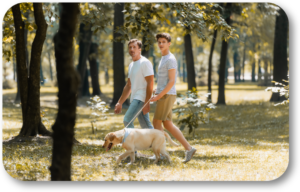Last Tuesday I was at a new Home Dog Training client in Dacula helping him with his eighteen-month-old Irish Water Spaniel named Cassidy. She was a sweet dog, but would run to the door whenever my clients came home, guests came over, or the UPS guy had a package for them. They didn’t want her to jump, bark, and run out the door. She also liked to nip them when she wanted attention and would always try to steal their food when they were having dinner. These were all standard behavior issues that we easily fixed as soon as my clients understood that they needed to take a more appropriate leadership position with Cassidy. They were very happy with the results we achieved and were confident that they could continue to practice appropriate leadership techniques with Cassidy from now on.

As we were finishing up, they had one more question. They told me that Cassidy was great when they would take her for walks in the neighborhood, the park, or around the lake where they have a weekend cabin. They understood the basic techniques for proper walking, but wanted to understand the proper guidelines or responsibilities they should be considering while out on their walks with Cassidy. I thought this was a great and thoughtful question and was happy to respond.
I always tell my clients that when we consider our relationship with our dog, we have to think of it as something similar to the relationship between a parent and their child. The parent is the care giver, provider, protector, and “ultimate friend” to their child. This is a natural, basic instinct within all of us living in a social community. We are also the care giver, provider, protector, and “best friend” to our dog. Our job, in this respect, is one that lasts every minute of every day, wherever we may be and wherever our dog may be.
So, when we take our dog for a walk, our job is much more than just holding the leash!
When we are out and about and walking our dog, it is very important that we let him know he is safe. Just when we were little kids and looked to our parents to keep us safe when we were at the mall, in a restaurant, or on the street, we must do the same thing with our dog. Because of this, our job is a lot bigger than we might think when we are out for a walk.
Here are some tips for your walk:
- Walk your dog next to you at a safe and comfortable distance. If you are in a crowded area, the distance may be three to six feet from you. If you are in a quiet neighborhood or countryside with minimal distractions or people, this can be a greater distance. Allowing your dog to safely explore the area helps him establish an appropriate baseline of personal safety.
- Always scan ahead of you. Look for squirrels, people, other dogs, kids on bikes, etc. You must be the radar to locate anything that might frighten or startle your dog.
- If you locate a problem ahead, be prepared to let him know that you will protect him or redirect him so that the distraction is minimized.
- If you miss a fearful distraction and your dog begins to bark/pull, bring your leash in (if needed), turn around, and walk in a direction away from the distraction. Walk to a quiet area and direct his attention towards you. Always remain calm and steadfast. Wait until the fearful distraction has passed before you continue your walk.
- Pick routes that naturally don’t have as many fearful distractions for your dog. We want to make the walk pleasant and to help strengthen his understanding that you are the leader and the person keeping him safe.
Although the guidelines I have mentioned above seem intuitively obvious, we often “drop the ball” and just don’t do them when on a walk. We may be on the phone, watching the “cool car” pass by, or performing other actions that take us away from our above stated responsibilities. Staying focused and being prepared for whatever may arise does not take a great deal of our “walk time”. If we adhere to our “dog owner” responsibilities, over 99% of our walk time will be about having fun with our dog.
Before I end, I want to mention one more thing. This is a situation that does not happen often, but for the few times it does occur, it really “sticks with you”. You can be responsibly walking your dog when someone may “just appear” and start to “get in your face” about something. They may not like the breed of your dog or they contend “you are walking on their sidewalk”. If you can see this “crazy” individual approach you, calmly turn around and go the other way at an accelerated pace. You just want to leave the area to avoid the situation.
If you are “too late” and you are now engaged with this “crazy” individual, stay calm. Say something bland, but courteous such as “Thank you for the information” or “I hope you have a nice day”. Turn around and calmly walk away. Your calm interaction and quick redirection helps your dog understand that you are in charge and you are keeping him safe.
Please call Robin or me at (770) 718-7704 if you need any dog training help. We are blessed to have been your local dog training professionals for over sixteen years. We have trained over 5,000 great dogs and loving families and are ready to help you.

Follow Us!